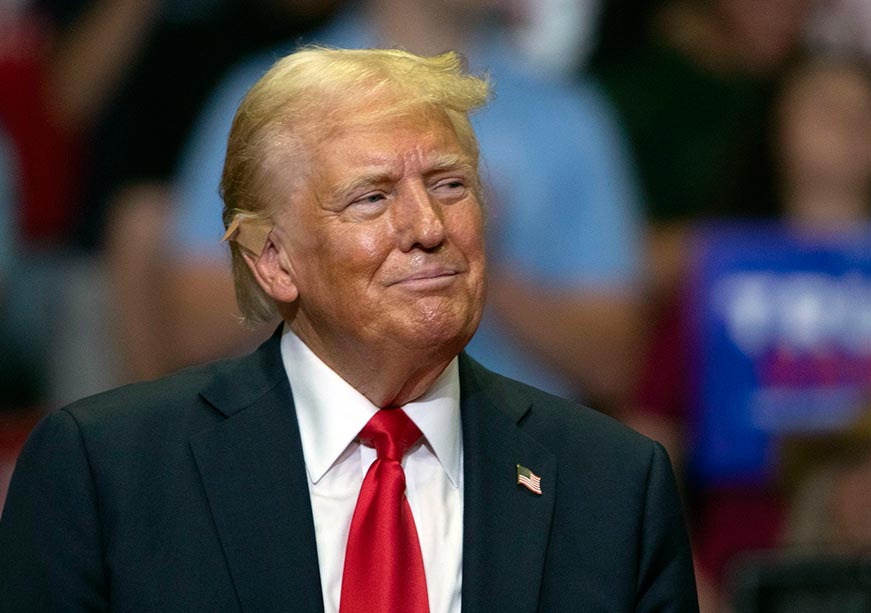-
CENTRES
Progammes & Centres
Location

Image Source: Getty
The ceasefire drawn between Lebanon and Israel on 27 November, which offered a glimpse of respite in the Middle East, stirring Biden’s legacy in the region in a somewhat positive direction, turned out to indeed be fragile. Two days after the ceasefire was agreed upon, the Syrian war drew great attention: the largest Syrian rebel group, Hayat Tahrir al-Sham (HTS) and its affiliates captured Aleppo, Syria’s second city, on 29 November. In the next eight days, it captured Hama and Homs. Subsequently, on the midnight of 8 December, Syria’s now former President Bashar-al Assad fled to Moscow as Damascus fell to the opposition forces, ending his family’s five-decade-long rule. America’s role in this part of the Middle East is in the limelight now more than ever.
Although HTS originally emerged as the al-Qaeda-affiliated al-Nusra Front in 2011, under al-Jolani’s leadership, it broke off ties with al-Qaeda, merged with other Syrian rebel groups, and came to be known as the ‘Hayat Tahrir al-Sham’, solely dedicating itself to fighting Assad’s regime, in 2017.
The Syrian civil war commenced in March 2011 out of a protest of discontent against Assad’s government. To suppress the countrywide protests, the government employed violent means, and as a response, the opposition forces took up arms and rebel groups emerged. Although HTS originally emerged as the al-Qaeda-affiliated al-Nusra Front in 2011, under al-Jolani’s leadership, it broke off ties with al-Qaeda, merged with other Syrian rebel groups, and came to be known as the ‘Hayat Tahrir al-Sham’, solely dedicating itself to fighting Assad’s regime, in 2017.
Steadily, the war drew international attention and sparked involvement from a plethora of stakeholders for reasons more than keeping the regime stable or opposing it: proxy wars, expanding geopolitical influence in the Middle East, and oil. Iran and Hezbollah were the first ones to support Assad, helping the Syrian army regain control of areas lost to rebels. This Iran-Hezbollah-Syria alliance came to be known as the “axis of resistance”, aimed at countering Israeli and Western interests in the Middle East. Subsequently, Russia’s military intervention against Syrian opposition began in October 2015, on Assad’s request, as his resources were depleting after years of countering opposition forces since 2011, particularly following his loss of the province of Idlib, officially joining the Axis.
The United States, along with Israel and several other Gulf states, entered the war in 2014 in an effort to target ISIS, with the Obama administration having briefly supported the opposition groups. As the Syrian regime was accused of using chemical weapons in the war, the US directly targeted the former for the first time in 2017. Since ISIS’ loss of 98 per cent of its territory the same year, America has largely been focused on avoiding the former’s resurgence and condemned the Assad regime’s methods, and has expanded its role in Syria by supporting the Kurdish-led Syrian Democratic Forces (SDF) in the region.
An interesting aspect to note is that American forces have been largely stationed along the eastern borders of Syria, an oil-rich area.
Under Trump 1.0, as he declared the official eradication of ISIS in 2019, large numbers of American troops were withdrawn from Syria, and since then, just 900 have remained on-ground. An interesting aspect to note is that American forces have been largely stationed along the eastern borders of Syria, an oil-rich area. The remaining troops were left stationed in Syria as Trump made Syrian oil a “US national security priority”, “guarding” the oil fields from ISIS, the regime and Russia.
Washington’s stakes in Syria persist despite the rebel groups having established nearly full control.
On December 4, as Secretary of State Antony Blinken outlined Washington’s plans for Syria in a press release, Biden and the incoming Trump administration find themselves at odds over their policies on Syria. Blinken stated that Biden has substantial “security interests” in Syria; apart from the primary one being preventing the resurrection of ISIS’ “geographic caliphate,” he also wants DC to engage with the de-escalation of violence in Syria and collaborate with the interim government to work toward ending the civil war. Since December 9, Washington has been carrying out airstrikes against ISIS targets in Syria.
Currently, while Biden has a long-term strategic vision for Syria, Trump wants America to merely be a spectator.
Nevertheless, as Trump 2.0 wants “nothing to do” with Syria, there may be several essential factors to consider before completely withdrawing. Syria offers Trump an opportunity to re-calibrate certain economic considerations:
Several countries have identified investment opportunities in Syria, including China, through its Belt and Road Initiative (BRI). While Syria officially joined the BRI in 2022, China has yet to invest in any projects there. However, with normalisation efforts underway and the interim government moving toward functionality, China could possibly advance its agenda in Syria.
While Syria officially joined the BRI in 2022, China has yet to invest in any projects there.
Moreover, Saudi Arabia and Syria agreed in 2023 to explore investment opportunities, coinciding with Syria's re-entry into the Arab League that same year. Additionally, on December 14, eight Arab League leaders met in Jordan to support Syria’s government transition, with potential Gulf State investments likely flowing into Syria as a result.
With the interim government prioritising economic recovery, a Trump 2.0 administration could seize the opportunity to negotiate a business deal with Syria. Especially if Gulf partners like Jordan, Egypt, and Saudi Arabia actively participate in Syria's redevelopment, the U.S. could explore collaborations similar to the I2U2 initiative.
Furthermore, if Trump adopts his version of “peace through strength” strategy—anchored in economic interests—toward the Middle East, Syria could become a potential business partner. This could yield a significant advantage for the US, allowing it to gain another “democratic” ally in the region alongside Israel, particularly as interim Prime Minister Mohammed al-Bashir has expressed a commitment to prioritising equal rights in Syria. Subsequently, this could provide Trump with a window to negotiate an oil agreement with Syria, if he wishes to establish such a deal with the latter.
Trump would face several other challenges if he materialises his stance to withdraw from Syria, the primary difficulty being managing the de-escalation of the remaining American troops. Consequently, a key consideration would be whether he intends to maintain control over the oil fields, an agenda he pursued during his first term.
Termination of support for the Kurdish forces would be another challenge, as this cooperation has been a crucial pillar for maintaining American influence in Syria and strengthening ties with Israel.
Trump would face several other challenges if he materialises his stance to withdraw from Syria, the primary difficulty being managing the de-escalation of the remaining American troops.
Furthermore, while Hezbollah’s top leadership has been dismantled and it does not plan to infiltrate Syria for the time being, the group’s return remains a potential future concern that Trump’s Middle East policy may need to address.
Israel seized the UN-supervised de-militarised buffer zone surrounding Golan Heights, as Netanyahu said he did not want “hostile forces” stationing themselves in the area, as this region shares borders with Israel. Netanyahu further justified the seizure by claiming that the border disengagement agreement, signed in May 1974 with the Syrian government, is no longer valid because the Syrian government has fallen, and rebel forces have taken over.
Israel also carried out the “largest air attack in history” targeting Iranian assets on 9 December, shaking Damascus to its core. Subsequently, it has launched more than 480 strikes all across Syria since 10 December, showing no end in sight to its war with the Middle East. Israel’s ambitions are poised to be the foremost factor shaping Trump’s Middle East policy, and his challenge would be to navigate Tel Aviv’s inflated expectations of him in light of his isolationist policies.
Navigating NATO cohesion remains challenging due to Turkey’s opposition and recent airstrikes on America-backed Kurdish forces in Syria. Since Assad’s fall, the Turkish-backed Syrian National Army (SNA) has fought the US-backed SDF to eliminate the latter from northern Syria and establish an autonomous “liberated” zone. However, in its efforts to prevent an ISIS resurgence, Washington has aligned itself with the SDF. A Trump 2.0 administration would face critical decisions about balancing relations with Turkey while deliberating if he wants to keep pursuing counter-ISIS objectives in Syria.
The EU has affirmed support for Syria’s development, an effort which could require boots on the ground, further increasing pressure on NATO, especially given the fact that Trump 2.0 may consider “exiting” NATO or, more realistically, potentially limit its funding.
Additionally, one of America’s primary responsibilities would be controlling Syrian immigration to the States, which tops Trump’s to-do list. Controlling immigration would primarily entail ensuring the Syrian state’s democracy and facilitating development.
The EU has affirmed support for Syria’s development, an effort which could require boots on the ground, further increasing pressure on NATO, especially given the fact that Trump 2.0 may consider “exiting” NATO or, more realistically, potentially limit its funding.
Most importantly, perhaps, Trump 2.0 will have to navigate how to scale back Biden’s efforts to engage with a new Syria if he wants to let the situation play out for itself. While Biden and Trump stand at a crossroads, Trump’s isolationist agenda must consider key factors such as a growing Chinese influence in the Middle East, managing relations with Israel, deciding whether to maintain engagement with Kurdish forces and continuing counter-terrorism efforts in Syria, while addressing the critical question of oil.
These considerations may demand a more nuanced approach from a Trump 2.0 who prioritises an “America first” approach. Striking a balance between isolationism and strategic engagement will be essential for shaping a coherent Syria policy.
Kashvi Chaudhary is a Research Intern at the Observer Research Foundation.
The views expressed above belong to the author(s). ORF research and analyses now available on Telegram! Click here to access our curated content — blogs, longforms and interviews.

Kashvi Chaudhary is a Research Intern at the Observer Research Foundation ...
Read More +